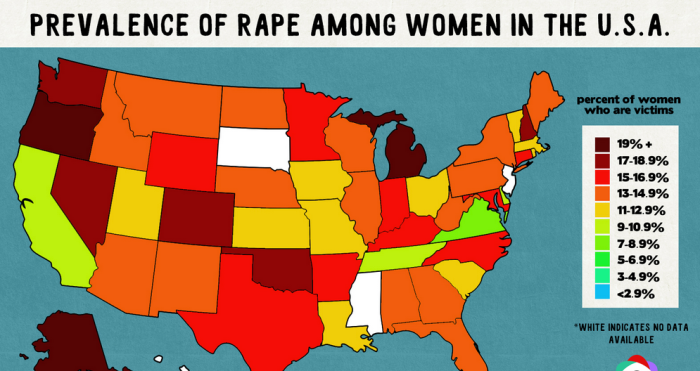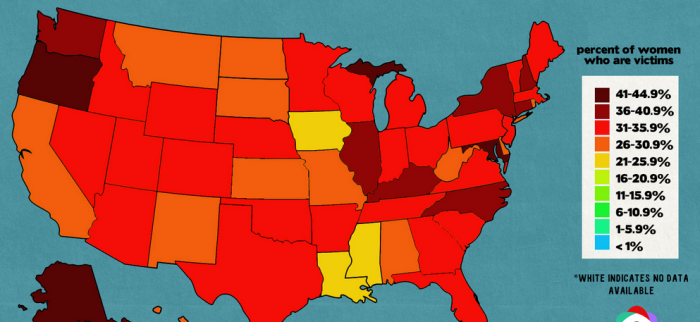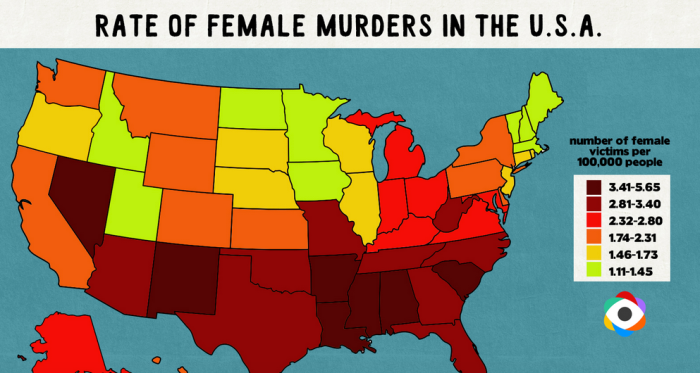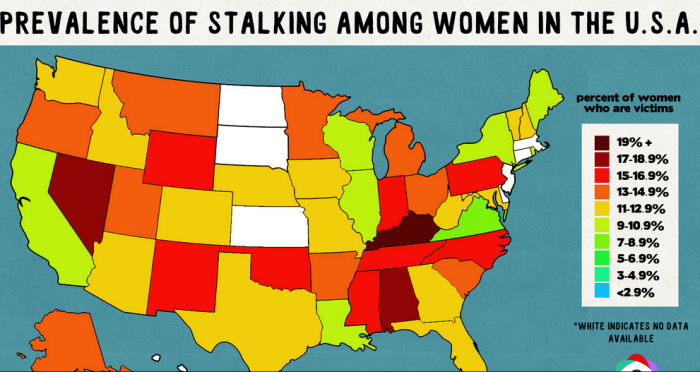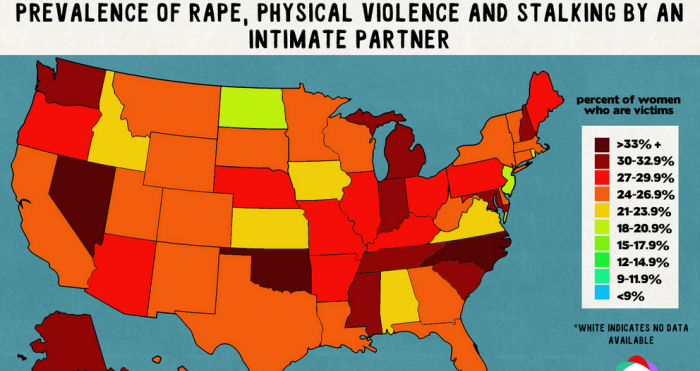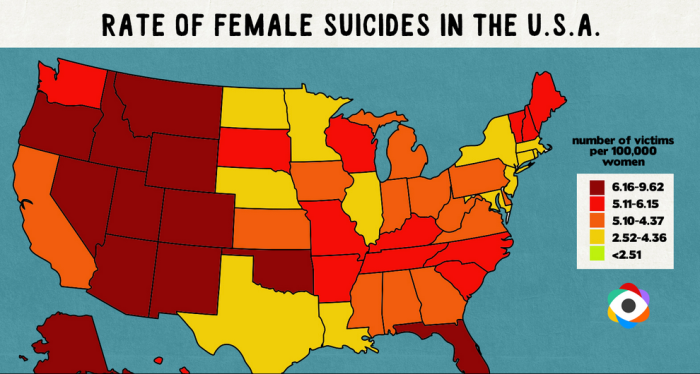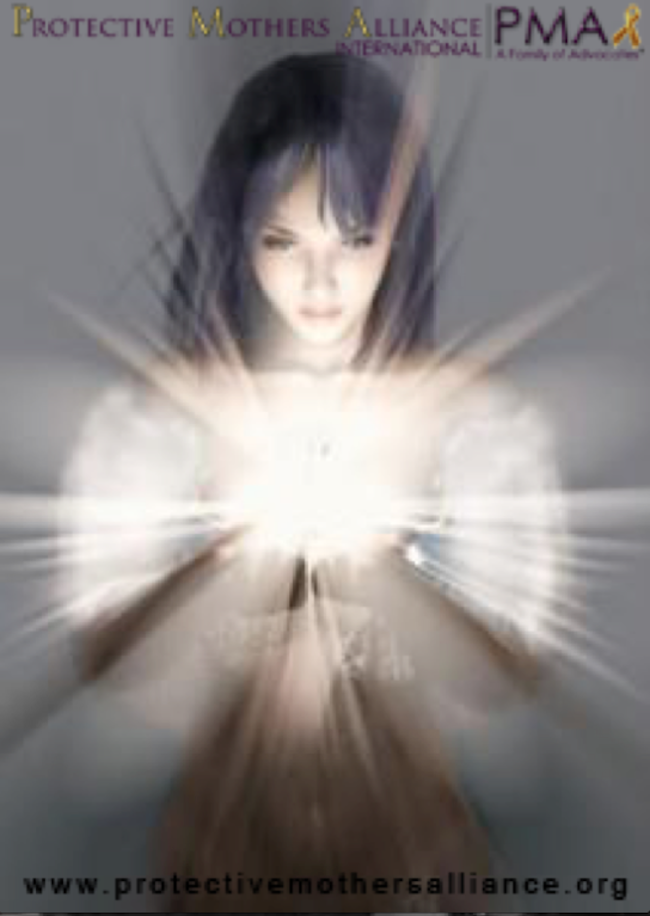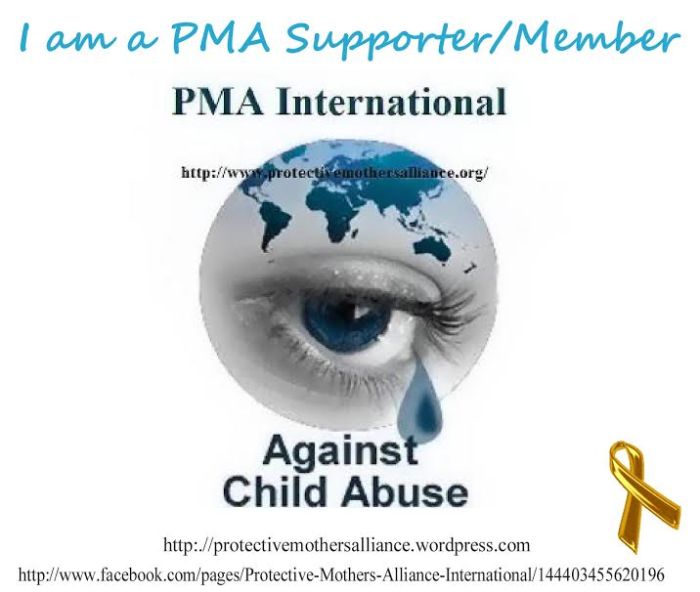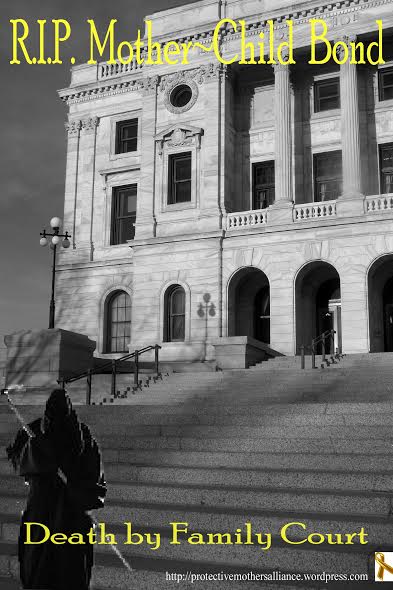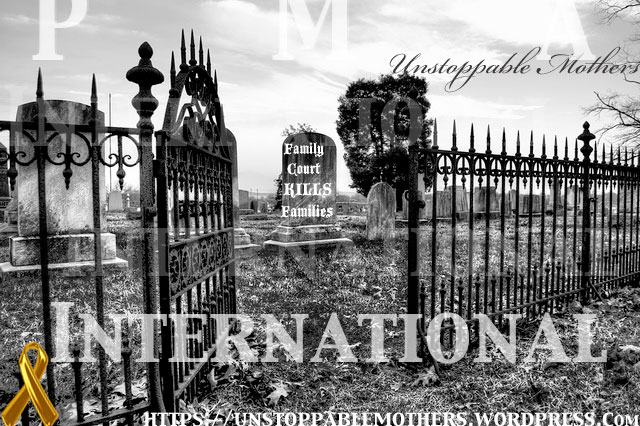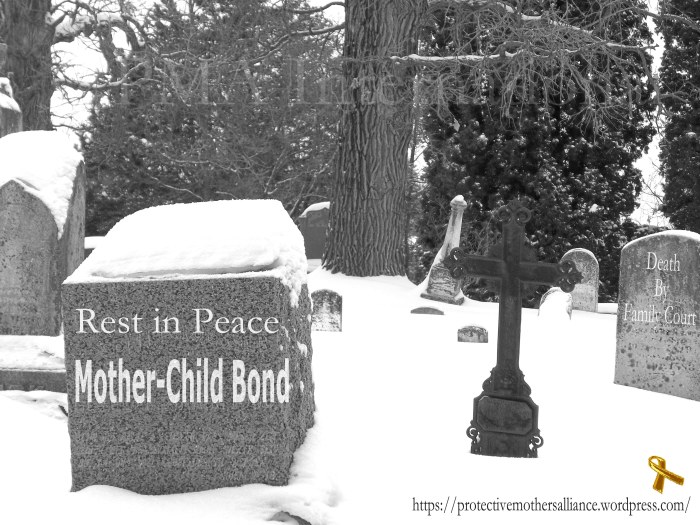Posts Tagged ‘Sexual abuse’
PIXABLE DATA: These Are The Most Dangerous States In America To Be A Woman/ Pixable
Every nine seconds, a woman is assaulted in the U.S.A. This statistic from the National Coalition Against Domestic Violence may seem shocking, but not when you take into account that one third of American women will be sexually assaulted within their lifetime — one third. That means one out of every three women you know (your sisters, daughters, mothers and friends) will likely fall victim to this awful crime.
The true scope of how many women have been attacked or victimized, especially by people they know, is terrifying. What’s even more terrifying is everything we don’t know. The last published results of the National Intimate Partner and Violence Survey are from 2010.
The closest we could get to finding real, recent answers on the frequency of sexual assault and rape in the last couple of years is from the FBI. The legal definition of rape was recently changed to include both male and female victims, but the FBI still includes statistics of the legacy definition (female victims only) in their annual crime report. We expected the FBI’s crime report to more or less match the figures from the CDC’s 2010 survey, but we noticed a drastically low number of rape victims — roughly 26 women per 100,000 people.
That’s when we realized a key fact. The FBI is basing their figures on arrests and convictions, excluding statutory rape and incest and only documenting “forcible rape.” The sad truth is that most rapes go unreported — with forcible rapes making up only a fraction of all reported rapes — and even less rapists are actually convicted. According to RAINN less than half of all rapes are reported, only 12% of what is reported actually leads to an arrest and only 3% of rapists see punishment for their actions.
When it comes to violence against women, not every zip code is equal, and some places are more dangerous than others. We’ve examined statistics from the FBI, the CDC’s 2010 comprehensive National Intimate Partner And Violence Survey and the U.S. Census Bureau to narrow down the most dangerous places for women in the United States from 2010 – 2014.
One out every six women in the U.S.A. was a victim of an attempted or completed rape in 2010.
Places like Alaska and Oregon hold the highest rates of rape against women, whereas states like Virginia and California hold some of the lowest rates. The 2014 information from the FBI also shows a different perspective than that of the above statistics from the CDC. While many of the same states are still on the top 10 list, some new states appear as well. This could be for a number of reasons. There could have been an increase or decrease in crime in the last four years among certain states or some states could just have a higher rate of conviction due to differing justice systems.
The 10 states with the largest percentage of women in 2010 who said they were raped in their lifetime are:
1. Alaska (21%)
2. Oregon (21%)
3. Michigan (20%)
4. Nevada (18.8%)
5. New Hampshire (18.7%)
6. Oklahoma (18.6%)
7. Washington (18%)
8. Colorado (18%)
9. Minnesota (16.9%
10. Connecticut (16.9 %)
In 2014, These were the states with the most rapes per 100,000 according to the FBI
1. Alaska (75.3)
2. New Mexico (51.4)
3. South Dakota (48.4)
4. Montana (42)
5. Michigan (40.9)
6. Arkansas (39.8)
7. Colorado (39.6)
8. North Dakota (37.3)
9. Kansas (37)
10. Arizona (36.6)
Sexual crimes against women (other than rape) are even more commonplace. These results from the 2010 CDC report are eye-opening.
At the lowest rate, which occurs in Louisiana, 22% of women have experienced sexual violence other than rape. Most states fall somewhere between the 30 and 35% mark, while others like Oregon see 43% of women falling victim to non-rape sexual violence. The 10 states where women are most frequently sexually assaulted are:
1. Oregon (43.3%)
2. Alaska (42%)
3. Maryland (41.9%)
4. New Hampshire (40.8%)
5. Washington (40.5%)
6. Illinois (38.6%)
7. North Carolina (38.3%)
8. New York (38%)
9. Connecticut (37.2%)
10. Kentucky (36.8%)
One of the most obvious ways to determine if a place is dangerous is by looking at the murder rate. The murder rate for females in 2010 was notably higher in certain states.
States in the southern half of the United States have a notably higher murder rate among females than states in the northern half. Southern states also have looser gun laws.
According to the CDC, in 2010, the states with the most murders per 100,000 people are:
1. Louisiana (4.44)
2. Mississippi (4.13)
3. Alabama (3.85)
4. New Mexico (3.69)
5. South Carolina (3.57)
6. Arkansas (3.48)
7. Nevada (3.48)
8. Georgia (3.32)
9. Tennessee (3.1)
10. North Carolina (3.07)
Stalking doesn’t always lead to violence, but it can. Even still, stalking is far less common than sexual assault but worth mentioning. This is the percentage of women in 2010 who reported having been stalked in their lifetimes.
In Kentucky, the state with the highest percent of incidents, 19% of women report being stalked. Most states see an 11-13% rate of stalking, while the states with the lowest instances, Wisconsin and Virginia, see a rate of 9.8% and 8.6% respectively. The states with the highest percentage of women who have been stalked are:
1. Kentucky (19%)
2. Alabama (18.4%)
3. Nevada (17.7%)
4. Oklahoma (16.6%)
5. New Mexico (16.4%)
6. North Carolina (16%)
7. Tennessee (15.3%)
8. Wyoming (15.2%)
9. Mississippi (15.1%)
10. Pennsylvania (15%)
Four out of every five assaults are committed by someone the victim already knows (a friend, boyfriend, acquaintance, etc), and one third of women are assaulted by an intimate partner. The 2010 report shows the sheer number of women who reported being assaulted by an intimate partner within their lifetimes.
Considering 94% of women who are murdered and four fifths of women who are raped are attacked by someone they know, these statistics are particularly telling. These states have the highest percentage of women who have been raped, physically assaulted, or stalked by an intimate partner.
1. Oklahoma (36.8%)
2. Nevada (34.8%)
3. North Carolina (33%)
4. Michigan (32.5%)
5. Washington (32.4%)
6. Maryland (32%)
7. New Hampshire (32%)
8. Alaska (32%)
9. South Carolina (31.7%)
10. Tennessee (30.6%)
When labeling the most dangerous places for women, it may also be important to consider a woman’s mental health. A cluster of states seem to have had a notably higher suicide rate between 2004 and 2010.
If the attack is on oneself, versus a homicide or physical assault from another party, does it still count? Regardless of genetic predisposition to depression and self-harm, situations that lead a woman to suicide are perhaps indicators of an unhealthy environment.
States with highest rates of suicide per 100,000 people are:
1. Alaska (9.62)
2. Nevada (9..62)
3. Wyoming (8.19)
4. New Mexico (8.06)
5. Montana (7.96)
6. Colorado (7.76)
7. Oregon (7.23)
8. Arizona (7.18)
9. Florida (6.40)
10. Idaho (6.31)
The problem is still growing, which is why we need more information.
Despite the most comprehensive and accurate report being from 2010, the frequency of rape among women has not decreased. According to the FBI, the figures rose 1.6% between 2013 and 2014. This leads us to the question, why isn’t there a more recent CDC study on domestic abuse if the problem is growing? How many women will really be assaulted (sexually or otherwise) in their lifetimes? How many women were actually affected within the last year alone and didn’t report it to the police?
Perhaps if people are more aware of the massive scale of the problem, it could help lead to a change. For every woman who says it can never happen to me, who truly believes it’s only a problem for a few unfortunate people, there is another woman who understands that it can happen to anyone and it does happen to anyone, even if she remains silent in her understanding.
There is help out there for women who find themselves in trouble. If you need help and you’re in the U.S., call 1-800-799-SAFE (7233) for the National Domestic Violence Hotline or 1-800-656-HOPE (4673) for the National Sexual Assault Hotline.
Posttraumatic Stress Disorder / http://traumadissociation.com/ptsd
What is Posttraumatic Stress Disorder? Posttraumatic Stress Disorder (PTSD) is a very common mental health disorder, affecting 8.7% of people during their lifetime. The core symptoms are: re-experiencing the trauma psychologically (flashbacks and nightmares) avoiding reminders of the trauma emotional numbing hyperarousal (irritability, and being jumpy or constantly “on alter”) Who gets PTSD? PTSD is also known as posttraumatic stress syndrome (PTSS) and is not caused by normal, everyday stress. PTSD can occur at any age, it can occur during childhood, adolescence, adulthood and old age.
Posttraumatic stress disorder affects around 5% of men and 10% of women at some point during their life. Up to one in three people who experience a traumatic event develop PTSD as a result. — National Health Service, UK
PTSD causes different people to react in very different ways, and it can be very disabling. “The disturbance, regardless of its trigger, causes clinically significant distress or impairment in the individual’s social interactions, capacity to work or other important areas of functioning.”
Recovery from PTSD Recovery rates vary: the DSM-5 states around 50% of adults with PTSD may recover within 3 months but some people have PTSD for over a year. In some cases, PTSD has continued for over 50 years, for example in Vietnam war veterans and Holocaust survivors. Santiago et al. (2013) reviewed many studies of PTSD, finding that 50% recovered within 2 years.
As the graph shows, a third of people exposed to trauma develop PTSD (33%), and recovery is significantly quicker in people exposed to unintentional trauma, for example natural disasters, life-threatening illness or accidents.
Factors know to hinder recover, or worsen symptoms after trauma include: reminders of the original trauma normal ‘life stressors’, for example unemployment, illness or bereavement new traumatic experiences worsening physical declining health or cognitive function (in older people) social isolation can exacerbate symptoms
What causes PTSD?
Causes of PTSD: 10 common causes
Only a small percentage of people with PTSD are traumatized by combat. source: Spence et al. (2011).
Being female doubles the risk of a person developing PTSD; the reasons for this are not yet understood.
The type of trauma experienced strongly affects the risk of developing PTSD; many studies show that rape causes the highest rates of PTSD, with over 50% of rape survivors affected.
Read more: http://traumadissociation.com/ptsd
CAN THE FAMILY COURT GET UP TO SPEED ON THE PAST FORTY YEARS OF CHILD SEXUAL ABUSE RESEARCH?/ Lundy Bancroft
Originally posted by our own Lundy Bancroft on his Healing and Hope blog (link below)
http://lundybancroft.blogspot.com/2012/02/can-family-court-get-up-to-speed-on.html
Family courts across the continent are continuing to operate largely disconnected from the last four decades of research and clinical writing on incest perpetration, including the stories of survivors. The unfortunate result in many cases that I have researched is that court and court-appointed personnel are basing their decisions on myths and misconceptions that went out long ago, sometimes leading to disastrous results for children and their non-offending parents. Here are some of the key points that family courts are often missing (I use “he” for the suspected perpetrator and “she” for the alleged victim, since this is statistically the most common scenario):
* A child’s relationship with a parent that is sexually abusing her will often have some positive (or at least positive appearing) aspects.
Courts in some cases stop looking carefully at evidence of sexual abuse by a father if they get reports that the child is sometimes happy to see him, is physically affectionate with him, or expresses interest in seeing him. The reality is that incest perpetrators typically develop a bond (though not a healthy one) with their victims through doing favors, giving positive attention, expressing love (and even describing the sexual abuse as proof of that love), and buying gifts. This is extremely confusing for the child and tends to leave her with powerful ambivalent feelings and adds to the difficulty she faces in making the hard decision of whether to disclose his behavior, and then whether to testify against him.
Furthermore, incest perpetrators do profound psychological damage to their victims without being horrible to them all the time. In fact, survivors say that the positive-appearing aspects of their relationships with their fathers made the emotional wounds in many ways deeper and harder to heal from.
I have been involved in a number of cases where court personnel acknowledged that the sexual abuse had occurred or had probably occurred, but then have gone on to state that the child’s relationship with the father has some positive aspects, and therefore is very important to preserve in an extensive form. This conclusion does not follow from the research evidence regarding harm and is specifically contradicted by survivors’ stories; contact between an incest perpetrator and a victim should occur only with highly-trained and vigilant supervision, and should stop any time the victim wishes it to or starts to show significant emotional deterioration following visits.
* It is common for a victim to recant disclosures of sexual abuse some time later, and even more so in cases where she has continued to have unsupervised contact with the suspected perpetrator.
Incest perpetrators are known to control and intimidate the victim in various ways following a disclosure; commonly reported tactics include threatening to harm the child or actually doing so, telling the child that he will go to jail if she doesn’t recant, threatening to harm the mother, telling the child that she will never get to see him (the father) again if she doesn’t recant, promising her purchases, vacations, or other rewards in return for recanting, and promising her that the abuse will stop in return for recanting. Obviously the more extensive access the suspected perpetrator has to the child through visitation, phone calls, texting, and email, or if the child is continuing to live with him, the greater the risk of a forced recantation.
* The suspected perpetrator will make angry, outraged, and hurt-sounding denials in close to 100% of cases. A correctly-accused perpetrator will be very difficult to distinguish by his public behavior, including his behavior at court, from one who is false accused. The perpetrator is often a respected and successful member of the community.
Courts have to rely on the evidence, not on how the suspect presents himself or what his public reputation is like.
* Incest perpetration is almost always surrounded by a other behaviors by the man that violate the child’s boundaries in subtler, less overtly illegal, ways. These behaviors usually begin well before the outright sexual abuse begins, and then continue along side it.
Courts sometimes make the mistake of discounting evidence of boundary violations toward a child “because they don’t rise to the level of sexual abuse.” Such boundary violations need to be taken seriously always, but in a case where there are other indications of sexual abuse — such as a child’s disclosure, for example — such lower level boundary violations should be treated as evidence pointing to the likelihood that the outright sexual abuse being disclosed did in fact take place.
* It is virtually unheard of for children younger than teenagers to make up reports of sexual abuse, and even in teenagers it is very rare.
Mistaken reports of sexual abuse do not come from children making them up. They come from one of the following sources: 1) A statement by the child that was misinterpreted by adults; 2) The child having been manipulated or intimidated into making the false allegation. Proper unbiased investigation makes it possible to find out if one of these two is functioning in a case.
* Most sexual abuse allegations that are brought to the attention of family courts are brought in good faith, not as a “tactic.”
Every large-sample study that has been done has found that true reports of sexual abuse are substantially more common than mistaken ones even when they occur in the context of child custody litigation. Further, the research has found that even most mistaken allegations are brought in good faith, meaning that the parent heard a disclosure or witnessed behaviors that would have worried most responsible parents. And finally, the research shows that sexual abuse allegations that are deliberately false are made equally by fathers and mothers; there is no basis for the belief that women are especially likely to make a false sexual abuse report during litigation.
* Domestic violence perpetrators (specifically, men who batter women), have been found in study after study to commit a far higher rate of incest than non-battering men do.
You can read a review of many studies on the subject in Chapter 4 of my book The Batterer as Parent. When there is persuasive evidence of a history of domestic violence, courts should make sure to investigate sexual abuse disclosures, and reports of lower level (not illegal) boundary violations, by that father with even more care and diligence.
* When a child discloses sexual abuse to a parent (by anyone), the parent needs to believe the child and take every possible step to protect her.
It may seem odd that I have to say this, but it is regrettably common for mothers in family courts to be criticized for believing the child, particularly if other systems such as child protection or the family court have declared that they cannot find enough evidence to restrict the father’s visitation. If a mother persists in believing her child, and tries to explain the different ways in which systems failed to make a properly thorough and unbiased investigation, she may have various negative labels attached to her by court personnel or may be threatened with having the child removed from her even if any other responsible parent in her position would also remain concerned, given the facts of the case.
Everything I wrote above remains true if the child making the disclosure is a boy, by the way.
It is my fervent hope that family courts across the continent will take rapid steps to get themselves in alignment with the research and with the published accounts of survivors. A tremendous number of lives are in the balance.
“NEVER GIVE UP”/ Yolanda Adams
“Never Give Up”
Visions that can change the world trapped inside an ordinary girl
She looks just like me too afraid to dream out loud
And though it’s simple your idea, it won’t make sense to everybody
You need courage now If you’re gonna persevere
To fulfill divine purpose, you gotta answer when you’re called
So don’t be afraid to face the world against all odds
[Chorus]
Keep the dream alive don’t let it die
If something deep inside keeps inspiring you to try, don’t stop
And never give up, don’t ever give up on you
Don’t give up
Every victory comes in time, work today to change tomorrow
It gets easier, who’s to say that you can’t fly
Every step you take you get, closer to your destination
You can feel it now, don’t you know you’re almost there?
To fulfill divine purpose, you gotta answer when you’re called
So don’t be afraid to face the world against all odds
[Chorus]
Keep the dream alive don’t let it die
If something deep inside keeps inspiring you to try, don’t stop
And never give up, don’t ever give up on you
[Bridge:]
Who holds the pieces to complete the puzzle?
The answer that can solve a mystery
The key that can unlock your understanding
It’s all inside of you, you have everything you need yeahhhh
Sooooo, keep the dream alive don’t let it die
If something deep inside, keeps inspiring you to try don’t stop
And never give up, don’t ever give up on you
Sometimes life can place a stumbling block in your way
But you’re gotta keep the faith, bring what’s deep inside your heart yeah your
Heart to the light
And never give up Don’t ever give up on you
Nooo don’t give up,
No, no, no, no don’t give up
Oh, no, no, no, no don’t…give…up
UNSTOPPABLE MOTHERS
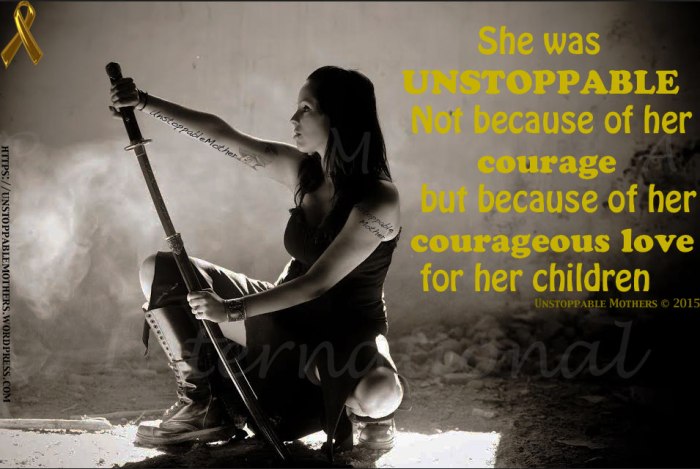
Welcome to PMA International’s Unstoppable Mothers
Protective Mothers Alliance International (PMA) has launched Unstoppable Mothers, a powerful photo and essay project to give voice to Protective Mothers and their Children.
The photos depict the loss and grief a Protective Mother experiences when she is forcibly separated from her child(ren) due to family court injustice, the events she missed in the life of her child or abuser quotes.
The essays, in Protective Moms’ own words, are common real life family court situations. Protective Mothers reveal the most outrageous action a judge took in their case.and/ OR, the Protective Mom shares what she has missed most about not being in her child’s life and/or the Protective Mom shares her abuser’s quotes.
How Can You Participate?
Protective mothers may send their quotes to the comment section of our new Unstoppable Mothers blog devoted specifically to this Unstoppable Mothers Campaign.
https://unstoppablemothers.wordpress.com
Protective mothers may also read some earlier quotes on this site at-
https://protectivemothersalliance.wordpress.com/unstoppable-mothers/
All signs, quotes, and pictures will be posted on our new Unstoppable Mothers” blog devoted specifically to this Unstoppable Mothers’ campaign
https://unstoppablemothers.wordpress.com
PMA International will put the Unstoppable Mother’s quote on a sign , an appropriate picture or an image for the project.
Some signs with quotes will be combined with missed milestone pictures taken by PMA International’s talented protective mothers, highlighting their creativity and photography skills.
Some feedback about “Unstoppable Mothers'” photo and essay project;
“Beautiful photography by talented PMA protective mothers, coupled with heartbreaking real life stories of loss in the mothers’ own words. Another stunning PMA Intl. project to raise awareness. TY Janice, Lundy and all the PMA moms!!”
G.S
“Participating in this project was very empowering and gave me hope”
S.C
“Thank you for capturing a protective mother’s powerful story through her own words and beautiful pictures .”
M.J
“Thank you for giving us moms a voice along with gorgeous visuals from talented protective mothers.”
K.R
” Powerful”
J.S
Now that we all understand how to participate and what the ground rules are for this project, Protective Mothers’ Alliance International invites you into our project; a window to our world. We ask you to brace yourselves, step slowly into our shoes, carefully take a step , steal a tiny glimpse , and taste a tiny bite of what life is like as a protective mother. An unstoppable protective mother, enduring one of the darkest atrocities known in the history of our civilization.
Enter:
https://protectivemothersalliance.wordpress.com/unstoppable-mothers/
